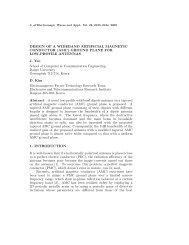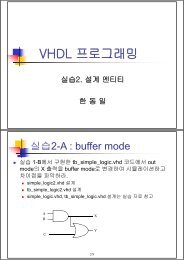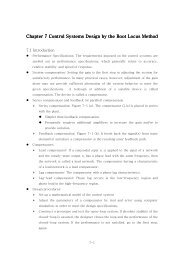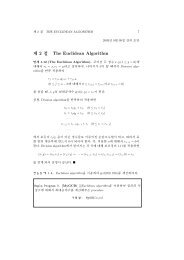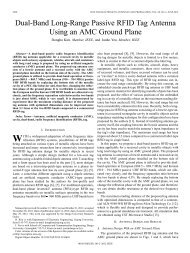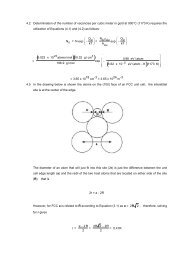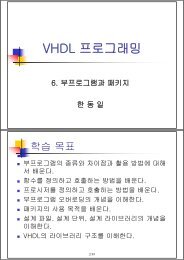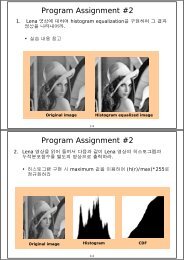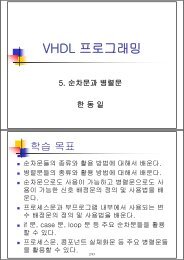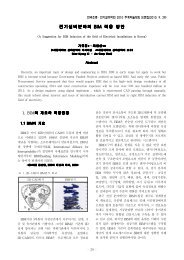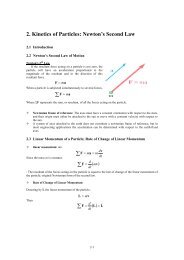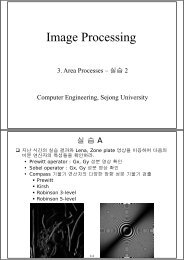Internal generation of waves for extended Boussinesq equations
Internal generation of waves for extended Boussinesq equations
Internal generation of waves for extended Boussinesq equations
You also want an ePaper? Increase the reach of your titles
YUMPU automatically turns print PDFs into web optimized ePapers that Google loves.
162<br />
( )<br />
C. Lee et al.rCoastal Engineering 42 2001 155–162<br />
<strong>waves</strong> which pass through the wave <strong>generation</strong> point<br />
cause no serious numerical distortion while the incident<br />
<strong>waves</strong> are generated at the point. The numerical<br />
results <strong>of</strong> internal <strong>generation</strong> <strong>of</strong> sinusoidal <strong>waves</strong>,<br />
with different water depths ranging from shallow to<br />
deep waters, show that the energy transport approach<br />
gives wave amplitudes properly. However, the mass<br />
transport approach gives wave amplitudes different<br />
from the desired ones by the ratio <strong>of</strong> phase to energy<br />
velocities. The technique <strong>of</strong> internal <strong>generation</strong> <strong>of</strong><br />
<strong>waves</strong> shows the capability <strong>of</strong> generating nonlinear<br />
cnoidal <strong>waves</strong> as well as linear sinusoidal <strong>waves</strong>.<br />
Although the numerical experiment supports that the<br />
energy transport is a proper approach to internally<br />
generating <strong>waves</strong> in the <strong>extended</strong> <strong>Boussinesq</strong> <strong>equations</strong>,<br />
a theoretical investigation would be much<br />
valuable.<br />
Acknowledgements<br />
The first author wishes to acknowledge the financial<br />
support <strong>of</strong> the Korea Science and Engineering<br />
Foundation Ž no. 2000-1-31100-001-3.<br />
during the visit<br />
<strong>of</strong> the University <strong>of</strong> Delaware. The second author<br />
wishes to acknowledge the financial support <strong>of</strong> the<br />
Korea Science and Engineering Foundation Žno.<br />
1999-2-311-005-3 ..<br />
References<br />
<strong>Boussinesq</strong>, J.V., 1872. Theorie ´ des ondes et des remous qui se<br />
propaent le long d’un canal rectangulaire horizontal, en communiquant<br />
au liquide contenu dans ce canal des vitesses<br />
sensiblement pareilles de la surface au dond. J. Math. Pures<br />
Appliq. 17, 55–108.<br />
Chen, Y., Liu, P.L.-F., 1995. Modified <strong>Boussinesq</strong> <strong>equations</strong> and<br />
associated parabolic models <strong>for</strong> water wave propagation. J.<br />
Fluid Mech. 288, 351–388.<br />
Chen, Q., Madsen, P.A., Schaffer, ¨ H.A., Basco, D.R., 1998.<br />
Wave–current interaction based on an enhanced <strong>Boussinesq</strong><br />
approach. Coastal Eng. 33, 11–39.<br />
Copeland, G.J.M., 1985. A practical alternative to the Amild-slopeB<br />
wave equation. Coastal Eng. 9, 125–149.<br />
Larsen, J., Dancy, H., 1983. Open boundaries in short wave<br />
simulations—a new approach. Coastal Eng. 7, 285–297.<br />
Lee, C., Suh, K.D., 1998. <strong>Internal</strong> <strong>generation</strong> <strong>of</strong> <strong>waves</strong> <strong>for</strong> timedependent<br />
mild-slope <strong>equations</strong>. Coastal Eng. 34, 35–57.<br />
Madsen, P.A., Larsen, J., 1987. An efficient finite-difference<br />
approach to the mild-slope equation. Coastal Eng. 11, 329–351.<br />
Madsen, P.A., Schaffer, ¨ H.A., 1998. Higher-order <strong>Boussinesq</strong>-type<br />
<strong>equations</strong> <strong>for</strong> surface gravity <strong>waves</strong>: derivation and analysis.<br />
Philos. Trans. R. Soc. London A 356, 3123–3184.<br />
Madsen, P.A., Sorensen, O.R., 1992. A new <strong>for</strong>m <strong>of</strong> the <strong>Boussinesq</strong><br />
<strong>equations</strong> with improved linear dispersion characteristics:<br />
Part 2. A slowly varying bathymetry. Coastal Eng. 18, 183–<br />
204.<br />
Madsen, P.A., Murray, R., Sorensen, O.R., 1991. A new <strong>for</strong>m <strong>of</strong><br />
the <strong>Boussinesq</strong> <strong>equations</strong> with improved linear dispersion<br />
characteristics. Coastal Eng. 15, 371–388.<br />
Nwogu, O., 1993. Alternative <strong>for</strong>m <strong>of</strong> <strong>Boussinesq</strong> <strong>equations</strong> <strong>for</strong><br />
nearshore wave propagation. J. Waterw., Port, Coastal Ocean<br />
Eng. 119, 618–638.<br />
Peregrine, D.H., 1967. Long <strong>waves</strong> on a beach. J. Fluid Mech. 27,<br />
815–827.<br />
Press, W.H., Teukolsky, S.A., Vetterling, W.T., Flannery, B.P.,<br />
1992. Numerical Recipes in Fortran: The Art <strong>of</strong> Scientific<br />
Computing. 2nd edn. Cambridge Univ. Press, pp. 42–47.<br />
Radder, A.C., Dingemans, M.W., 1985. Canonical <strong>equations</strong> <strong>for</strong><br />
almost periodic, weakly nonlinear gravity <strong>waves</strong>. Wave Motion<br />
7, 473–485.<br />
Suh, K.D., Lee, C., Park, W.S., 1997. Time-dependent <strong>equations</strong><br />
<strong>for</strong> wave propagation on rapidly varying topography. Coastal<br />
Eng. 32, 91–117.<br />
Wei, G., Kirby, J.T., Grilli, S.T., Subramanya, R., 1995. A fully<br />
nonlinear <strong>Boussinesq</strong> model <strong>for</strong> surface <strong>waves</strong>: Part 1. Highly<br />
nonlinear unsteady <strong>waves</strong>. J. Fluid Mech. 294, 71–92.<br />
Wei, G., Kirby, J.T., Sinha, A., 1999. Generation <strong>of</strong> <strong>waves</strong> in<br />
<strong>Boussinesq</strong> models using a source function method. Coastal<br />
Eng. 36, 271–299.<br />
Yoon, S.B., Lee, J.I., Lee, J.K., Chae, J.W., 1996. Boundary<br />
treatment techniques <strong>of</strong> numerical model <strong>for</strong> the prediction <strong>of</strong><br />
harbor oscillation. J. Korean Soc. Civ. Eng. 16, 53–62, ŽIn<br />
Korean ..



